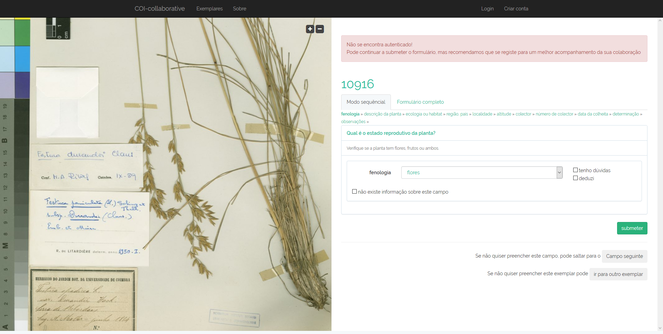|
Biodiversity Information Science and Standards : Conference Abstract
|
|
Corresponding author: Joaquim Santos (joaquimsantos@gmail.com)
Received: 28 Jun 2019 | Published: 02 Jul 2019
© 2019 Joaquim Santos, Fátima Sales, Paulo Rupino
This is an open access article distributed under the terms of the Creative Commons Attribution License (CC BY 4.0), which permits unrestricted use, distribution, and reproduction in any medium, provided the original author and source are credited.
Citation: Santos J, Sales F, Rupino P (2019) Accelerating Digitisation of Biological Collections: the Coimbra Herbarium case study. Biodiversity Information Science and Standards 3: e37760. https://doi.org/10.3897/biss.3.37760
|
|
Abstract
Hebaria are biological collections of preserved plants, algae, fungi and lichens used for scientific purposes. Fast communication and information exchange are fundamental to accelerate the investigation on biodiversity. The major world herbaria are concentrating efforts to digitise their collections and making available the information online.
Over the last decade, the Herbarium of the University of Coimbra (COI – acronym in Index Herbariorum) has made efforts to make available online the information of its plant collection of c. 800,000 specimens (http://coicatalogue.uc.pt). However, only c. 10% is processed to this date, in part due to the slowness of the methods generally used in herbaria. This work is a contribution to accelerating the digitising process, both by improving digitising procedures and by involving citizens in populating COI database.
To accomplish that, a new workflow was developed to automatically create records in the database from batches of digital images with minimum information, plus a collaborative platform was developed to allow the transcription of specimen labels from digital images in a web environment.
Creating records from the images benefits from the physical organisation of the herbarium, with specimens grouped in taxon folders. This way, when taking pictures of a set of specimens, it is possible to store them in folders with the name of the taxon. A script will then read the name of the folder and check in the database if each ranking of the taxon exists on the taxon tree (genus, species, infraspecific ranks), and in case it does not, it creates one, and then it creates a record based on each of the specimens inside that folder assigning a determination to it.
The collaborative application (http://coicatalogue.uc.pt/collaborative) has innovative features, such as displaying forms sequentially, revealing only one field at a time (Fig.
Collaborative application: user categories and roles.
|
Role |
Category |
Description |
Accepted submissions required |
Points attributed to each submission |
|
CONTRIBUTOR |
Basic |
First time user. Fields displayed are restricted. |
0 |
10 |
|
Beginner |
More fields are displayed, but some are restricted. |
10 |
20 |
|
|
Competent |
More fields are displayed, but some are restricted. |
50 |
30 |
|
|
Advanced |
More fields are displayed, but some are restricted. |
100 |
40 |
|
|
Expert |
Can submit all fields. |
500 |
50 |
|
|
ADMINISTRATOR |
Administrator |
Can perform all tasks above, data management (submission approval). |
- |
50 |
|
ROOT |
Root |
Can perform all tasks above, administrator management, specimen management. |
- |
50 |
Although collateral, there is a major, and unique, advantage to this project. The collaborative application can be used as a tool to make corrections to the herbarium database, easily and directly online. This quickly improves the database as such effortless procedure increases this kind of contributions.
Keywords
collaborative applications, digitising herbaria, automate databasing processes, specimen annotation, community data editing
Presenting author
Joaquim Santos
Presented at
Biodiversity_Next 2019
Hosting institution
Herbarium of the University of Coimbra
